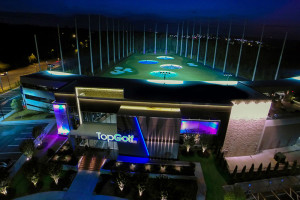Based on the most recent statistics of the National Golf Foundation, there were approximately 25.3 million golfers in the U.S. in 2012, which is a three percent decrease of the total number of golfers just two years prior. The panel Old Game, New Tricks: What’s the Future of Golf? will be conducted by a group of four influential and progressive members of the golf industry. This panel will speak to the about the future of golf and what solutions are in place to help reinvent the golfing experience.
 Charlie Kautz is one of the members of this panel. He is a marketing consultant with experience working for TaylorMade – adidas Golf Company and served as a project manager for Hack Golf – a new, open innovation initiative aimed at making golf more fun for everyone. Here is my Q&A with Mr. Kautz about the state of golf.
Charlie Kautz is one of the members of this panel. He is a marketing consultant with experience working for TaylorMade – adidas Golf Company and served as a project manager for Hack Golf – a new, open innovation initiative aimed at making golf more fun for everyone. Here is my Q&A with Mr. Kautz about the state of golf.
Q: What do you believe have been the biggest factors in golf’s decline? Is it the lack of Tiger Woods and Phil Mickelson-esque star power not creating as much television drama, or are there other contributing factors?
A: There are dozens of factors, but ultimately the two biggest contributing factors that share the most blame are time and money. Golf takes too long, and it’s too expensive – that’s the historic rhetoric, and it still rings true in 2015. There’s been incredible progress to knock down the game’s exclusivity barriers, especially in the last 10-15 years – for example, the R&A lifted its 260-year ban on female members last fall – but still a lot of work to do on all fronts. Golf 20/20 has a lofty hope and goal for golf to “look like America” – a melting pot of players participating, consuming, taking up the game. It’s a beautiful dream, but to that point, the first monumental challenge is turning around the decline.
Q: Do you think that the PGA/individual golfers should do more to market the sport to the average sports fan to entice them to watch golf? To get younger children to start playing golf? Do you believe golf as a whole is effectively using social media (or other marketing channels) to reach out to fans?
A: I think golf is in an infinitely better spot than say, five years ago, when you look at the non-traditional media space and absolutely the marquee, millennial players like Rickie Fowler deserve a lion’s share of the credit for bringing the younger generation of players into the fold by meeting them where they’re consuming media. Look no further than the PGA Tour’s recent announcement of “Skratch TV” – a video-media platform designed to deliver fast, fun, relevant content from the Tour to your smartphone – and you’ll see the game’s major entities are working their damnedest to capture the heart, mind and interest of kid golfers. The scale at which professional tours and their respective players are influencing and delivering sport-related messages to the golf audience is bigger than ever before – millions and millions of impressions every day – and the hope is for that to continue to grow exponentially, both domestically and abroad.
Eat. Sleep. Breathe. Golf. #EncourageEveryoneIn4Words pic.twitter.com/DlV4eIYwNF
— TaylorMade Golf (@TaylorMadeGolf) March 2, 2015
Q: Are adjustments to the game necessary for the rebirth of golf? Jack Nicklaus has suggested widening the cup. Would a change within the game entice more people to play?
A: It all depends who you ask. Certainly initiatives like the 15″ cup and ‘Foot Golf’ have altered golf from its original format to draw new, different audiences to the game or likenesses of the game – but there is no silver bullet in terms of enticing people to take up the game. I think the broad range of initiatives in golf like Junior Golf League, Get Golf Ready, and the Drive, Chip and Putt Championship have positioned the game for unprecedented potential growth with juniors and new players in the next 5-7 years. The good news is the industry has never been more aware of its pitfalls – there isn’t an organization, be it a manufacturer, task force, or small business in golf that isn’t supporting growth, or the stoppage in decline, in some capacity.
Q: What impact has Top Golf had? I view Top Golf as a form of entertainment, not somewhere I would go to improve my golf game. From what you have seen, has it increased golf viewership or tournament attendance? Has it created more buzz about the game?
 A: I think the beauty of Top Golf is the audience it’s brought into the game. There are figures reported anywhere from 50 to 75 percent of their visitors are non-golfers – an incredible statement about the product they’re offering. To be able to draw people who wouldn’t otherwise touch a golf club, and strip down the fear and intimidation of learning golf by making it fun and fearless in an arcade environment is a remarkable achievement, and one that should be lauded. But, will players who spend a Saturday night at Top Golf, drinking beers and hitting at targets, play 18 holes the next Sunday afternoon? That’s the million dollar question. Is Top Golf creating new golfers? For now, I think golf can be encouraged by the amount of success, attention, and consumers Top Golf is drawing to their facilities and we’ll know more about the data in two, three, maybe even five years.
A: I think the beauty of Top Golf is the audience it’s brought into the game. There are figures reported anywhere from 50 to 75 percent of their visitors are non-golfers – an incredible statement about the product they’re offering. To be able to draw people who wouldn’t otherwise touch a golf club, and strip down the fear and intimidation of learning golf by making it fun and fearless in an arcade environment is a remarkable achievement, and one that should be lauded. But, will players who spend a Saturday night at Top Golf, drinking beers and hitting at targets, play 18 holes the next Sunday afternoon? That’s the million dollar question. Is Top Golf creating new golfers? For now, I think golf can be encouraged by the amount of success, attention, and consumers Top Golf is drawing to their facilities and we’ll know more about the data in two, three, maybe even five years.
Saturday, March 14
9:30AM – 10:30AM
Four Seasons
Ballroom AB
98 San Jacinto Blvd
